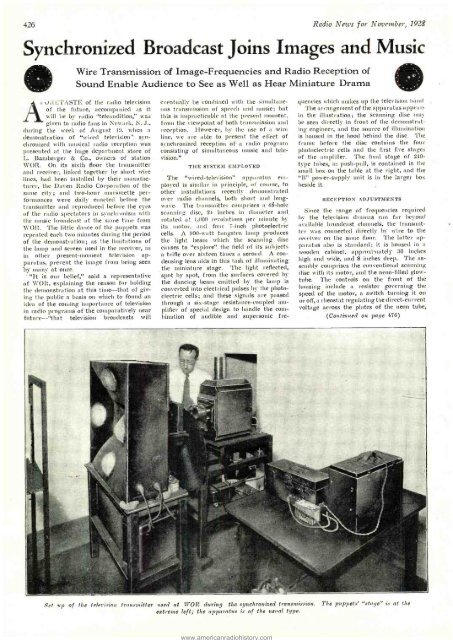TELEVISION NUMBER - AmericanRadioHistory.Com
TELEVISION NUMBER - AmericanRadioHistory.Com
TELEVISION NUMBER - AmericanRadioHistory.Com
You also want an ePaper? Increase the reach of your titles
YUMPU automatically turns print PDFs into web optimized ePapers that Google loves.
www.americanradiohistory.com<br />
426 Radio News for November, 1928<br />
Synchronized Broadcast Joins Images and Music<br />
Wire Transmission of Image- Frequencies and Radio Reception of<br />
Sound Enable Audience to See as Well as Hear Miniature Drama<br />
A<br />
JitETASTE of the radio television<br />
of the future, accompanied as it<br />
will be by radio "teleaudition," was<br />
given to radio fans in Newark, N. J.,<br />
during the week of August 19, when a<br />
demonstration of "wired television" synchronized<br />
with musical radio reception was<br />
presented at the huge department store of<br />
L. Bamberger & Co., owners of station<br />
WOR. On its sixth floor the transmitter<br />
and receiver, linked together by short wire<br />
lines, had been installed 1w their manufacturer,<br />
the Daven Radio Corporation of the<br />
same city; and two -hour marionette performances<br />
were daily enacted before the<br />
transmitter and reproduced before the eyes<br />
of the radio spectators in synchronism with<br />
the music broadcast at the saune time from<br />
WOR. The little dance of the puppets was<br />
repeated each two minutes during the period<br />
of the demonstration; as the limitations of<br />
the lamp and screen used in the receiver, as<br />
in other present- moment television apparatus,<br />
prevent the image from being seen<br />
by many at once.<br />
"It is our belief," said a representative<br />
of WOR, explaining the reason for holding<br />
the demonstration at this time-that of giving<br />
the public a basis on which to found an<br />
idea of the coming importimce of television<br />
in radio programs of the comparatively near<br />
future -"that television broadcasts will<br />
eventually be combined with the simultaneous<br />
transmission of speech and music; but<br />
this is impracticable at the present moment,<br />
from the viewpoint of both transmission and<br />
reception: However, by the use of a wire<br />
line, we are able to present the effect of<br />
synchronized reception of a radio program<br />
consisting of simultaneous music and television."<br />
THE SYSTEM EMPLOYED<br />
The "wired -television" apparatus employed<br />
is similar in principle, of course, to<br />
other installations recently demonstrated<br />
over radio channels, both short and long -<br />
wave. The transmitter comprises a 48 -hole<br />
scanning disc, 24 inches in diameter and<br />
rotated at 1,000 revolutions per minute by<br />
its motor, and four 7 -inch photoelectric<br />
cells. A 900 -watt tungsten lamp produces<br />
the light bean which the scanning disc<br />
causes to "explore" the field of its subjects<br />
a trifle over sixteen times a second. A condensing<br />
lens aids in this task of illuminating<br />
the miniature stage. 'l'he light reflected,<br />
spot by spot, from the surfaces covered by<br />
the dancing beam emitted by the lamp is<br />
converted into electrical pulses by the photoelectric<br />
cells; and these signals are passed<br />
through a six -stage resistance -coupled amplifier<br />
of special design to handle the combination<br />
of audible and supersonic fre-<br />
quencies which makes up the television band<br />
'l'he arrangement of the apparatus appears<br />
in the illustration; the scanning disc man<br />
be seen directly in front of the demonstrating<br />
engineer, and the source of illumination<br />
is housed in the hood behind the disc. 'l'he<br />
frame before the disc contains the four<br />
photoelectric cells and the first five stages<br />
of the amplifier. The final stage of 210 -<br />
type tubes, in push -pull, is contained in the<br />
small box on the table at the right, and the<br />
"B" power -supply unit is in the larger box<br />
beside it.<br />
RECEPTION ADJUSTMENTS<br />
Since the range of frequencies required<br />
by the television dramas ran far beyond<br />
available broadcast channels, the transmitter<br />
was connected directly .by wire to the<br />
receiver on the same floor. The latter apparatus<br />
also is standard; it is housed in a<br />
wooden cabinet, approximately 30 inches<br />
high and wide, and 8 inches deep. The assembly<br />
comprises the conventional scanning<br />
disc with its motor, and the neon -filled glow -<br />
tube. The controls on the front of the<br />
housing include a resistor governing the<br />
speed of the motor, a switch turning it on<br />
or off, a rheostat regulating the direct -current<br />
voltage across the plates of the neon tube,<br />
(Continued on page 476)<br />
Set up of the television transmitter used at IVOR during the synchronized transmission. The puppets' "stage" is nt the<br />
extreme left; the apparatus is of the usual type.
















